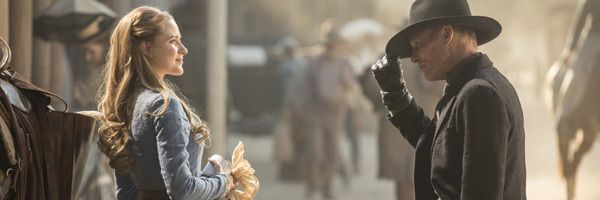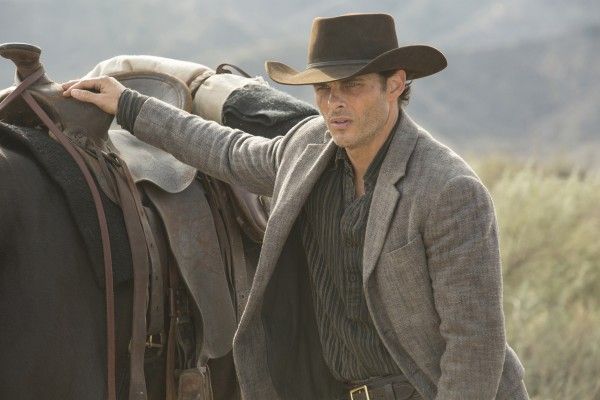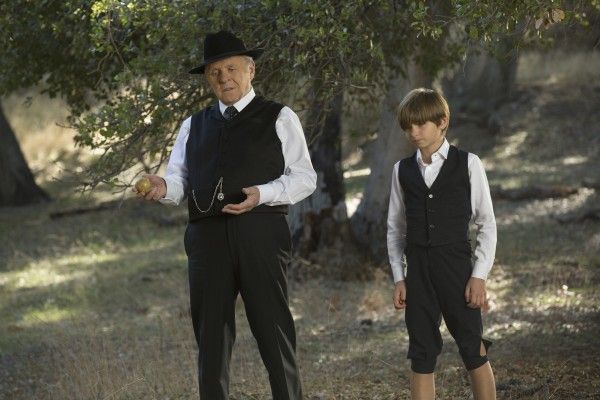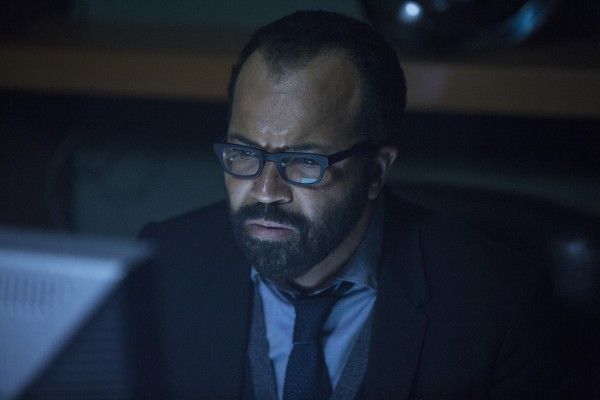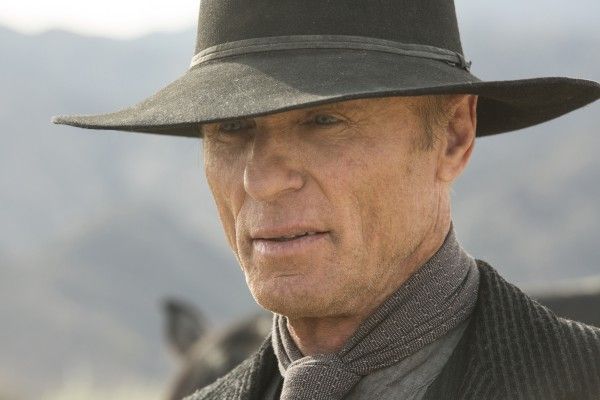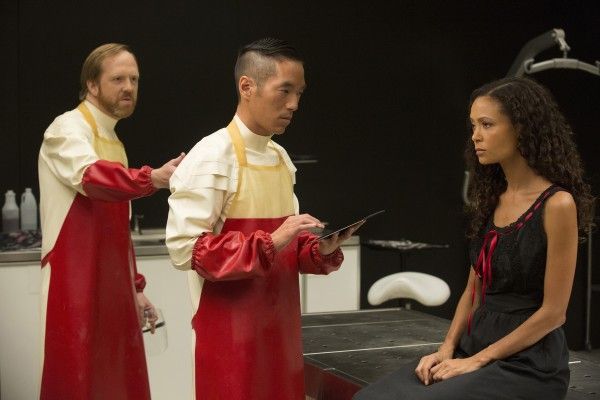Did Westworld’s audience surrogate character just die? We’ll have to wait until next week to see if curiosity killed the Elsie. If the Westworld programmer did bite the bullet (personally, I think she’ll be OK), she gave us — and Bernard — some vital information before she went, information that adds to our understanding of what is going on in Westworld’s quiet robot revolution. In “The Adversary,” the world of Westworld opened up even further. The addition of a new character gave us our first tangible glimpse at corporate parent Delos, while Maeve’s tour of the Westworld facilities broke hearts and brains in one of the most effective cinematic explorations of creation I have ever seen. Let's begin;
Lee Sizemore meets Charlotte Hale
It’s been a few episodes since we’ve seen British hot mess Lee Sizemore, a.k.a. one of Westworld’s chief narrative officers. Since Ford shot down Sizemore’s “Odyssey on Red River,” the self-centered Westworld employee has apparently been drowning his sorrows, pool-side, at the Mesa Bar. It is there he first meets Charlotte Hale, played by the always-welcome Tessa Thompson. Sizemore immediately comes on to the beautiful woman who strolls through his eye line. Like the narratives she suggests, he sees beautiful women only as supporting characters in his story. She is there to bring him pleasure.
In actuality, of course, Charlotte is actually there as a representative of Delos’ board of directors to oversee certain “transitions” in the park. This is something Lee learns later when he has just finished peeing all over the Westworld control room like a Jerry Maguire “I quit” walkout gone wrong. The moment is partially played for laughs — and it definitely gets some — but it also represents some major moves in the behind-the-scenes Westworld world. Is Charlotte here to talk Ford down? Will we finally learn more about those other purposes Lee and Theresa talked about in the very first episode? Whose side is Charlotte Hale on?
Teddy massacres an entire army outpost
While Lee is throwing a tantrum in the Westworld control room, Teddy unleashes his frustrations in a much more aggressive and deadly way. When Teddy and the Man in Black try to sneak past an army outpost to get to the front, Teddy is recognized from his mysterious, shameful past alongside Wyatt. Though we have come to expect displays of violence from the Man in Black, it is actually Teddy who kills to get the odd couple out of their current situation, turning a machine gun on dozens of Union soldiers. “You think you know someone,” the Man in Black tells Teddy with a twinkle in his eye. Teddy assures the Man in Black — and those of us at home — that we don’t know him. Like his beloved Dolores, he is done being a prop in someone else’s story. He is not all that he seems.
Bernard meets Ford’s family
Speaking of characters who are hard to get a handle on, we learn another layer of Ford’s story tonight when Bernard finds the secret host family he has been keeping off-book in Sector 17. Yes, it includes the little mini-Robert we have already met, as well as young versions of Ford’s real-life brother, father, and mother. They are the only hosts left to be built by Arnold, but were they meant as a gift or a threat? Given that Ford mentions that they are based on his only happy memory (family vacation in Cornwall), it seems like it would be the former.
It’s hard to get a hold on Ford and Arnold’s relationship. They were partners, but were they friends? How did Ford feel about Arnold’s death? Did he play a part in it? Was it his choice to erase Arnold’s legacy or did that come from corporate pressure? Does Ford miss Arnold?
Later, Ford discovers that Mini-Robert has killed his own dog. When questioned, Ford learns it is because Arnold told him to after the dog had killed a rabbit. Arnold convinced Mini-Robert that killing the dog was the only way to stop him from hurting things in a next-level throwback to the story Ford told Old Bill last week about his childhood dog killing a rabbit when he was younger. If Mini-Robert would kill his own dog upon Arnold’s command, then what or who else could he be convinced to kill? We’ve already seen how much control Ford has over the host inhabitants of Westworld. If Arnold has even more, than what hope do the guests have should Arnold decide to turn his creations against the humans for their own good?
Elsie exposes Theresa Cullen to Bernard
Elsie may be the only Westworld employee asking the right questions. Curiosity is in her nature and, like the aforementioned dead dog, doing what she is programmed to do could lead to her own demise. Following the clue of the satellite uplink she found burrowed in the Woodcutter’s arm, Elsie discovers that the satellite the uplink had been transmitting to actually belongs to Delos. Basically, if this is corporate espionage, then it is in-house. But for what purpose?
Elsie tracks the source of the tinkering to an old, creepy theater in Sector 3 where she learns that it was Theresa Cullen who hacked the Woodcutter, but that someone else has been using the bicameral system to give select hosts commands before that. That person is Arnold, and he is "a pretty prolific coder for a dead guy." Elsie gives this information to Bernard over the phone, but, before she can gather the data and meet Bernard back in his office, she is grabbed by someone in the dark theater. Is it Arnold? And, if so, is Arnold someone we know? What will he do with Elsie now that she is onto his secret mission? And what is Theresa Cullen up to? Does she know about “Arnold”’s tinkering? Are they working together or is she trying to solve the problem herself before it escalates into something even more dangerous?
Maeve sees creation
The most stirring storyline of the night again goes to Maeve, who convinces Felix (and later Sylvester) to explain her own creation to her before taking it into her own hands. Watching Maeve walk through the many levels of Westworld is one of the most moving, cinematic scenes of this entire series so far. Westworld does in three minutes what feature film Prometheus failed to do in two hours: effectively show the complexity of the interaction between creator and creation. Sure, Maeve doesn’t actually have a conversation (yet) with any of the men or women who have built her, but she sees behind the curtain. She is asked to hold the truth of her own existence next to the truth of how it came to be. The unromantic context of her, as seen by the employees of Westworld.
It is a testament to the strength of Maeve’s character (or whatever you want to call it) that she is able to take all of this in without curling up in the fetal position. Instead, she wants to take action. She convinces Felix and Sylvester to down her loyalty and up her intelligence way above the normal parameters, way above the intelligence capable of a human being, as we have previously established. What’s next? Maeve is going to have some fun. This is how the robot apocalypse begins, and I’m not sure we don’t deserve it.
Rating: ★★★★ Very good
Miscellanea:
-- The story of the maze, as explained by Teddy: The maze is the sum of a man’s life. A man who died many times, only to live again. Sick of violence, he built a house and built the maze around it so that no one could get to him. But that is just a native myth, right?
-- If the hosts of Ford’s family respond only to Ford’s voice, then we better hope that Ford never dies.
-- Many Westworld theories have been born and died in this first run of episodes, but one that still makes some sense is that Bernard is somehow Arnold, created by Ford. (A mention of Bernard’s dead son, the chief voice command Ford uses to control Bernard.) If this is the case, might Bernard be the one who is sending the hosts messages?
-- “I'm human, like the guests.” “How do you now?” — Maeve and Felix
-- Theresa breaks up with Bernard, which neither of them seem particularly happy about. Bernard obviously still cares about Theresa, worrying about her job in the potential corporate espionage fallout. How will Elsie’s discovery affect their relationship?
-- Thandie Newton continues to subtly nail it as Maeve. In a sea of great performances, hers might be the best so far.
-- We hear Theresa having a conversation with someone in China about an urgent situation in the park. Is this a member of the Delos board or someone else?
-- A list of the traits listed on Maeve’s tablet: Bulk apperception, courage, loyalty, humor, candor, vivacity, coordination, meekness, humility, cruelty, self-preservation, patience, decisiveness, imagination, curiosity, aggression, empathy, tenacity, sensuality, and charm.
-- Maeve originally has her cruelty at a “1,” which is actually really sweet. However, her empathy is only at a “9,” which doesn’t seem to follow with her ability to know what other people want/are thinking.
-- Someone has been making unlogged changes to Maeve’s programming even before they stepped in, upping her paranoia. Arnold has to be someone we know, right?
-- We learn that there are 82 first generation models in the park, with 47 designed by Arnold. Plan accordingly, Westworld guests and employees. This information could come in handy later.

